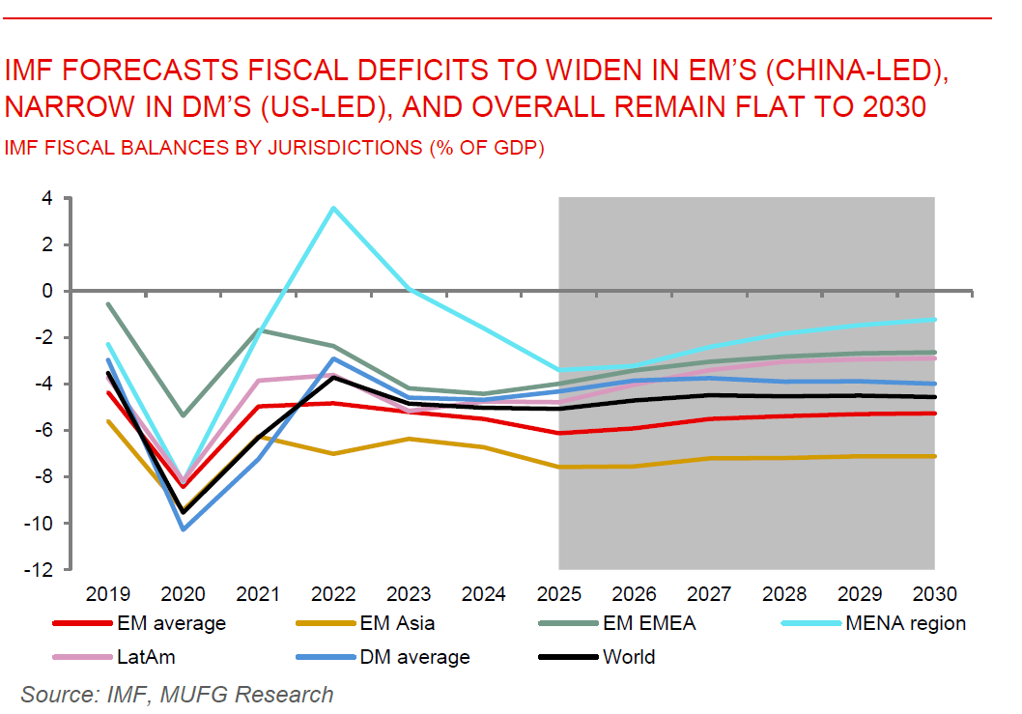To read the full report, please download the PDF above.
Middle East Daily
EHSAN KHOMAN
Head of Commodities, ESG and
Emerging Markets Research –
EMEA
DIFC Branch – Dubai
T:+971 (4)387 5033
E: ehsan.khoman@ae.mufg.jp
SOOJIN KIM
Research Analyst
DIFC Branch – Dubai
T: +44(4)387 5031
E: soojin.kim@ae.mufg.jp
MUFG Bank, Ltd. and MUFG Securities plc
A member of MUFG, a global financial group
Middle East Daily
GLOBAL MARKETS
IMF’s Fiscal Monitor report points to a worsening outlook. The recently released bi-annual IMF Fiscal Monitor report offers a value accretive overview of the medium-term fiscal outlook. Risks to the fiscal outlook have markedly intensified since the prior Fiscal Monitor report in October 2024, with fiscal projections subject to significant uncertainty given the rapid escalation of trade tensions and elevated levels of policy uncertainty. The IMF is projecting global fiscal dynamics remaining frail – whilst DM budget deficits are set to narrow from 4.7% in 2024 to 4.3% in 2025, EM budget deficits are estimated to widen further from 5.6% in 2024 to 6.3% this year. Debt levels are set to rise as revenues and output decline due to higher tariffs and increasing uncertainty. The IMF estimates that global public debt will rise by an additional 2.8ppts of GDP by 2025 and approach 100% of GDP by 2030, surpassing the COVID peak.
Fed 7 May FOMC preview – our US rates strategist sees rates remaining on hold. The US Federal Open Market Committee (FOMC) will meet on 7 May to decide whether to adjust the fed funds rate. Fed officials have accentuated downside risks from tariffs to their growth and inflation mandates, but have signalled their intent to wait further clarity. As was the case back in September 2024 when the current easing cycle began, our US rates strategist anticipates rising unemployment to propel the Fed into resuming cuts, and whilst our house view is that the Fed will keep rates on hold this week, a June cut is our base case – with an expectation of three 25bp cuts in a row (see here). Should the Fed skip June, then expectations may build for a 50bp cut again in July and/or continue on with 25bp cuts, with potentially up to 100bps of cuts in 2025.
MIDDLE EAST - MACRO / MARKETS
Non-oil growth steady in UAE while Saudi Arabia sees slowdown in April. PMI figures for April released this morning (5 May) pointed to a divergence in non-oil private sector performance between Saudi Arabia and the UAE. The UAE’s headline PMI held steady at 54.0 in April, signalling continued growth. Employment rose at the fastest pace in 11 months, and new orders increased to 56.9, supported by the strongest international demand in five months. Meanwhile, Saudi Arabia’s headline PMI dipped to 55.6 in April from 58.1 in March, marking the lowest level since August 2024 – albeit still in expansionary territory, and signifying continued expansion in the non-oil sector.
MIDDLE EAST - CREDIT TRADING
End of day comment – 02 May 2025. Another day of UST weakness post NFP driving spreads tighter. Over the last 2 days that repricing in UST has left spreads 5-10bp tighter in the main IG names. Despite the flattening of the UST curve though credit curves continue to steepen, take ADGB 30s closing -0.25pt/-10bp vs ADGB 54s -1pt/-3bp. Part of this though is that we had two low volume days where sticky bids in belly bonds with a short base led to the belly outperformance against more liquid long end bonds. ETF flows overall quiet but starting to sell long end benchmark bonds in the last hour of trading. New issues performing well in spread terms, especially DPWDU 35s had a retail bid throughout the day closing -0.25pt/-10bp. It’s hard to read much into the last 2 trading days given the low volumes. Risk is on in macro markets but we haven't seen the buying flows implied by the spread moves. In any case, the new issue window remains wide open and one should expect more supply.
COMMODITIES / ENERGY
Brent oil collapses below USD60/b on OPEC+ supply surge. Oil prices are fast-collapsing after OPEC+ agreed over the weekend to ramp-up production by a second consecutive 0.41m b/d increase for June deliveries (against 0.14m b/d previously). The motivation seemingly is in a bid to caution the group’s overproducing members (notably Kazakhstan and Iraq) to encourage enhanced compliance discipline. OPEC+ had initially planned to revive 2.2m b/d of paused production in modest monthly slivers to end-2026. Rather, OPEC+ had approved the return of almost half that amount in just several months but now appears to be contemplating bringing back its barrels at a rapid clip to market. The broader OPEC+ production increases we have witnessed this year are in line with our view we catalogued in our 2025 outlooks (see here and here), which we believe are motivated by a pivot from a strategy wherein OPEC+ had supported prices to an equilibrium wherein OPEC+ defends market share by restraining non-OPEC+ supply as well as fortifying internal unity and compliance. Against this backdrop, we believe that this OPEC+ strategy to move away from price support to market defence, reinforces our bearish oil price call on loose fundamentals – we estimate a 1.1m b/d global oil surplus in 2025. With this, we maintain our recently revised lower estimates of Brent crude to average USD66/b and USD62/b, in 2025 and 2026, respectively (see here).

